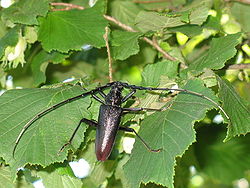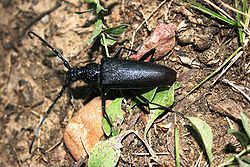| Cerambyx cerdo | |
|---|---|
 | |
| Scientific classification | |
| Kingdom: | Animalia |
| Phylum: | Arthropoda |
| Class: | Insecta |
| Order: | Coleoptera |
| Suborder: | Polyphaga |
| Infraorder: | Cucujiformia |
| Family: | Cerambycidae |
| Genus: | Cerambyx |
| Species: | C. cerdo |
| Binomial name | |
| Cerambyx cerdo | |
 | |
| European distribution of C. cerdo | |
| Synonyms | |
| |
Cerambyx cerdo, commonly known as the great capricorn beetle or cerambyx longicorn, is a species of beetle in family Cerambycidae. It occurs in North Africa (Algeria, Morocco, and Tunisia), Europe (Austria, Belarus, Bulgaria, Croatia, the Czech Republic, North Macedonia, France, Georgia, Germany, Hungary, Italy, Moldova, Poland, Portugal, Romania, Russia, Serbia, Slovakia, Spain, Sweden, Switzerland, and Ukraine), and Asia (Armenia, Azerbaijan, Georgia, Iran, and Turkey). [1]
Contents
The beetle was previously present in the United Kingdom but went locally extinct at least hundreds of years ago. Preserved specimens have been found in the UK, having been dated to around 4000 years old. [2] [3] It has been recorded in the UK since, but this is believed to be because of accidental human introduction due to wood transport. [4]



